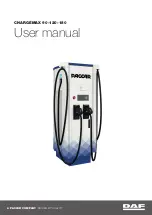
of injury in rear, side, or rollover collisions. The Ad-
vanced Front Air Bags will not deploy in all frontal
collisions, including some that may produce substantial
vehicle damage — for example, some pole collisions,
truck underrides, and angle offset collisions.
On the other hand, depending on the type and location of
impact, Advanced Front Air Bags may deploy in crashes
with little vehicle front-end damage but that produce a
severe initial deceleration.
Because air bag sensors measure vehicle deceleration
over time, vehicle speed and damage by themselves are
not good indicators of whether or not an air bag should
have deployed.
Seat belts are necessary for your protection in all colli-
sions, and also are needed to help keep you in position,
away from an inflating air bag.
When the ORC detects a collision requiring the Ad-
vanced Front Air Bags, it signals the inflator units. A large
quantity of non-toxic gas is generated to inflate the
Advanced Front Air Bags.
The steering wheel hub trim cover and the upper right
side of the instrument panel separate and fold out of the
way as the air bags inflate to their full size. The Advanced
Front Air Bags fully inflate in less time than it takes to
blink your eyes. The air bags then quickly deflate while
helping to restrain the driver and front passenger.
Occupant Classification System (OCS) — Front
Passenger Seat
The OCS is part of a Federally regulated safety system for
this vehicle. It is designed to provide Passenger Ad-
vanced Front Air Bag output appropriate to the occu-
pant’s seated weight, as determined by the OCS.
2
THINGS TO KNOW BEFORE STARTING YOUR VEHICLE
69
Summary of Contents for 2016 Dart
Page 4: ......
Page 7: ...1 INTRODUCTION 5 ...
Page 10: ......
Page 77: ...Not Seated Properly Not Seated Properly 2 THINGS TO KNOW BEFORE STARTING YOUR VEHICLE 75 ...
Page 162: ...160 UNDERSTANDING THE FEATURES OF YOUR VEHICLE ...
Page 163: ...3 UNDERSTANDING THE FEATURES OF YOUR VEHICLE 161 ...
Page 164: ...162 UNDERSTANDING THE FEATURES OF YOUR VEHICLE ...
Page 201: ...Voice Tree 3 UNDERSTANDING THE FEATURES OF YOUR VEHICLE 199 ...
Page 216: ...Voice Tree 214 UNDERSTANDING THE FEATURES OF YOUR VEHICLE ...
Page 218: ...216 UNDERSTANDING THE FEATURES OF YOUR VEHICLE ...
Page 220: ...218 UNDERSTANDING THE FEATURES OF YOUR VEHICLE ...
Page 222: ...220 UNDERSTANDING THE FEATURES OF YOUR VEHICLE ...
Page 224: ...222 UNDERSTANDING THE FEATURES OF YOUR VEHICLE ...
Page 266: ...One Half Second Tone Slow Tone 264 UNDERSTANDING THE FEATURES OF YOUR VEHICLE ...
Page 267: ...Slow Tone Fast Tone 3 UNDERSTANDING THE FEATURES OF YOUR VEHICLE 265 ...
Page 268: ...Fast Tone Fast Tone 266 UNDERSTANDING THE FEATURES OF YOUR VEHICLE ...
Page 306: ......
Page 423: ...Operating Tips Chart 4 UNDERSTANDING YOUR INSTRUMENT PANEL 421 ...
Page 424: ......
Page 494: ...492 STARTING AND OPERATING ...
Page 586: ......
Page 647: ...MAINTENANCE SCHEDULES CONTENTS 䡵 MAINTENANCE SCHEDULE 646 Required Maintenance 647 8 ...
Page 654: ......
Page 666: ......
Page 667: ...INDEX 10 ...
















































